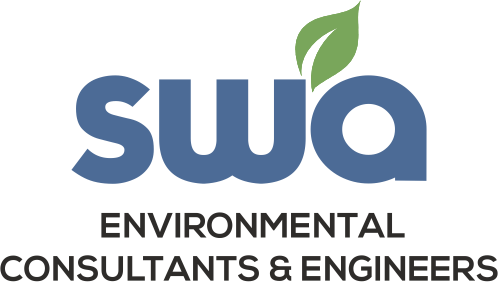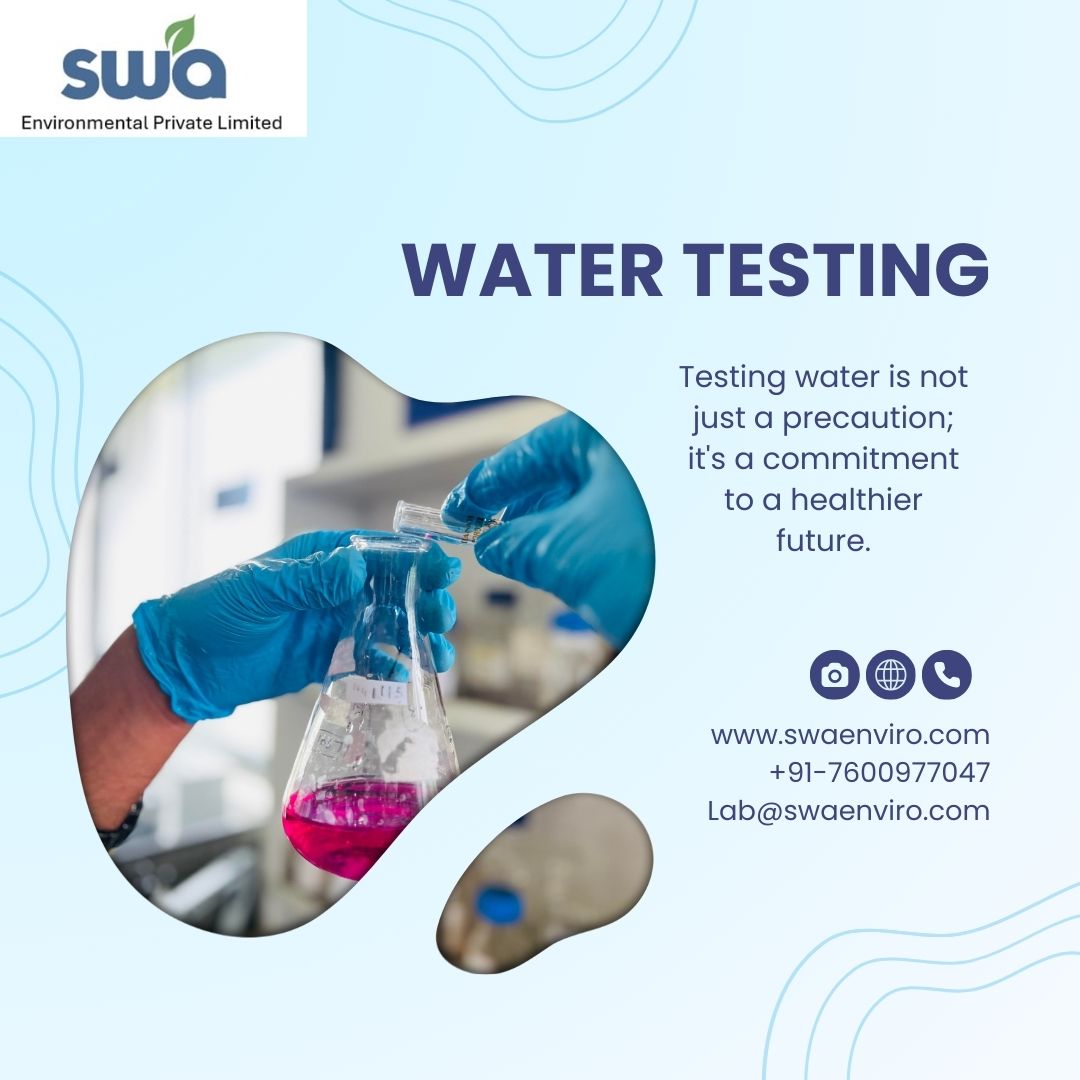Water Testing: Essential for Health and Safety
Water is vital for every part of our lives, from everyday tasks to critical needs. Don’t take chances—trust SWA Environmental Private Limited to make your water management effortless and dependable.

Why should we test water?
Testing water is like checking if your food is safe to eat. Just as you might look at a label to make sure your snack does not have anything bad in it, we test water to make sure it’s clean and safe to drink.
If water isn’t tested, it can lead to several harmful effects on our body like Digestive Problems, Toxic Reactions, Infections etc.

Testing water is essential as:
- Health safety: safety of health is very crucial for life of every individual so water must be tested as if not tested than there can be problems like
- Bacterial Contamination: Bacterial contamination from pathogens like E. coli, Salmonella, or Legionella can cause stomach issues like diarrhea, vomiting, and pain, and in severe cases, can lead to serious infections.
- Chemical contaminants: Chemical contaminants such as lead, pesticides, and industrial chemicals can be harmful; lead can impair child development, pesticides can cause poisoning or cancer, and other chemicals may also have serious health effects.
- Heavy Metals: Contaminants like arsenic, mercury, and cadmium can be toxic and may cause chronic health problems, including cancer, kidney damage, and neurological issues.
- Nitrates: High levels of nitrates, usually from farm runoff, can lead to a condition called “blue baby syndrome,” which makes it hard for infants’ blood to carry oxygen.
- Fluoride Levels: Fluoride helps prevent cavities, but too much can cause teeth to discolour and damage bones.
- Chemical Byproducts: Chemical byproducts from water treatment, like trihalomethanes, can increase the risk of cancer and other health problems with long-term exposure.
- Sediment and Particulates: High levels of sediment can cause issues with digestion and overall gut health, as well as clogging pipes and fixtures.
Types of Water Testing:
Water can be tested for both wastewater and freshwater to ensure that each type meets safety and quality standards.
1) Wastewater:
Wastewater testing is the process of checking dirty water to ensure it’s safe before it’s released back into nature. This dirty water comes from sources like household sinks, factories, and storm drains. Testing helps make sure it doesn’t contain harmful substances that could harm people or the environment.
For example, imagine water that comes from your sink or a factory. Testing this water helps us find out if it has harmful substances, like chemicals or germs. By doing this, we make sure the water is cleaned properly before it’s released into the environment, keeping our waterways and health safe.
A) Industrial Wastewater
Industrial wastewater is the dirty water produced by factories and manufacturing processes. This water often contains a mix of pollutants specific to the type of industry.
For example
Chemical Manufacturing
Example: A chemical plant producing solvents might have wastewater containing hazardous chemicals like acetone or benzene.
Pollutants: Organic solvents, heavy metals, and toxic compounds.
Textile Industry
Example: A textile mill dyeing fabrics can generate wastewater with bright dyes and finishing agents.
Pollutants: Dyes, detergents, and chemical additives.
Food Processing
Example: A food processing plant, such as one that makes canned goods, may produce wastewater with food residues, oils, and cleaning chemicals.
Pollutants: Organic matter, oils, and phosphates.
Pulp and Paper Industry
Example: A paper mill can create wastewater from the pulping process that contains wood fibres, lignin, and bleach chemicals.
Pollutants: Lignin, bleach, and other organic compounds.
Metal Manufacturing
Example: A steel mill might discharge wastewater from cooling and cleaning processes, which can contain heavy metals like chromium and cadmium.
Pollutants: Heavy metals, oils, and acids.
Petroleum Refining
Example: A refinery processing crude oil might produce wastewater with residual hydrocarbons, sulphur compounds, and heavy metals.
Pollutants: Hydrocarbons, sulphur compounds, and heavy metals.
Pharmaceutical Industry
Example: A pharmaceutical company manufacturing medications can generate wastewater with active pharmaceutical ingredients and solvents.
Pollutants: Active pharmaceutical ingredients, solvents, and chemical by-products.
Electronics Manufacturing
Example: An electronics factory that produces circuit boards may generate wastewater with chemicals used in etching processes, such as hydrochloric acid and copper.
Pollutants: Acids, metals, and solvents
B) Sewage water
Sewage water also known as domestic wastewater, comes from homes and public facilities. This includes water from sinks, toilets, showers, and washing machines.
Components of Sewage Water
Organic Matter
Example: Food scraps from kitchen sinks, human waste from toilets.
Details: Includes biodegradable materials like food particles, fecal matter, and urine, which can decompose and contribute to nutrient pollution if not treated.
Nutrients
Example: Nitrogen and phosphorus from detergents and human waste.
Details: These nutrients can lead to problems like algae blooms in water bodies, which deplete oxygen and harm aquatic life.
Pathogens
Example: Bacteria such as E. coli, viruses like hepatitis A, and parasites such as Giardia.
Details: These microorganisms can cause waterborne diseases and infections if sewage water is not properly treated.
Detergents and Soaps
Example: Residual laundry detergents and dish soaps.
Details: These can contain surfactants and chemicals that may be harmful to aquatic life and can affect water quality.
Chemical Contaminants
Example: Household cleaners, pharmaceuticals, and personal care products.
Details: Includes substances like bleach, disinfectants, and traces of medications that can persist in water and affect ecosystems.
Suspended Solids
Example: Particles from washing dishes, bathing, or flushing items.
Details: These solids can include bits of food, paper, and other small debris that need to be removed during wastewater treatment.
Organic Solids
Example: Toilet paper and other biodegradable materials.
Details: These are solid materials that decompose over time and can contribute to sludge in treatment processes.
Heavy Metals (in some cases)
Example: Trace amounts of metals from plumbing systems or household products.
Details: Metals like lead or copper can sometimes be present, though they are usually at lower concentrations compared to industrial wastewater.
2) Fresh Water:
Freshwater testing is the process of analyzing water from natural sources like rivers, lakes, and groundwater to assess its quality and safety. This testing helps determine if the water is clean and suitable for drinking, recreation, and other uses. Regular testing is crucial to ensure that freshwater resources remain safe and healthy for both people and the environment.

A) Ground water
Groundwater testing involves checking the quality of water found below the earth’s surface in aquifers, wells, and springs. This water comes from rain and other sources that seep into the ground, filling up underground layers of soil and rock. Testing is essential to ensure that this water is clean and safe for drinking, irrigation, and other uses.
Examples of Groundwater Testing
Private Wells: Homeowners with private wells test their water regularly to ensure it’s safe to drink. Common tests include checking for bacteria, nitrates, and heavy metals.
Agricultural Wells: Farmers test groundwater used for irrigation to ensure it doesn’t contain harmful levels of pesticides or fertilizers that could affect crops or soil.
Industrial Sites: Groundwater near factories or industrial sites is tested to check for pollutants like solvents or heavy metals that could be leaching into the water supply.
Municipal Supply Wells: Cities and towns test groundwater used in public water systems to ensure it meets safety standards before it’s distributed to residents.
B) Surface water testing
Surface water testing involves analysing water from sources like rivers, lakes, ponds, and streams. This testing helps determine if the water is clean and safe for various uses, such as drinking, swimming, fishing, and supporting wildlife.
Examples of Surface Water Testing
Swimming Areas: Water in lakes or pools where people swim is tested to ensure it’s free from harmful bacteria and pollutants that could cause illness.
Fishing Waters: Rivers and lakes used for fishing are tested for pollutants and toxins that could affect fish health and make the fish unsafe to eat.
Drinking Water Sources: Surface water used for municipal water supplies is tested to ensure it meets safety standards before being treated and distributed to homes.
Industrial Discharges: Water from industrial processes or runoff is tested to ensure it doesn’t contain harmful chemicals that could pollute nearby water bodies.
C) Sea water testing
It involves analysing the quality of water in oceans, seas, and coastal areas. This testing is crucial for monitoring the health of marine environments, ensuring safe recreational activities, and managing coastal resources. It helps identify pollutants, track changes in water quality, and protect marine life and human health.
Examples of Sea Water Testing
Coastal Water Ǫuality: Testing water near beaches and swimming areas to ensure it is safe for recreational use and free from harmful bacteria or pollutants.
Oil Spill Monitoring: Assessing sea water for oil contamination following spills to measure the extent of pollution and guide cleanup efforts.
Marine Ecosystem Health: Testing water in coral reefs and estuaries to monitor the impact of pollutants, temperature changes, and acidification on marine ecosystems.
Fishing Areas: Monitoring sea water in fishing zones to ensure that fish and shellfish are safe to eat, and that water quality supports sustainable fishing practices.
Climate Change Studies: Measuring changes in sea water temperature, salinity, and acidity to understand and predict the effects of climate change on marine environments.

Narrator: Maitri V Marvaniya, Marketing Intern, SWA Environmental Private Limited.

